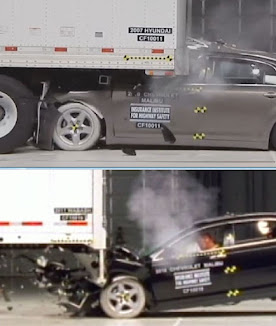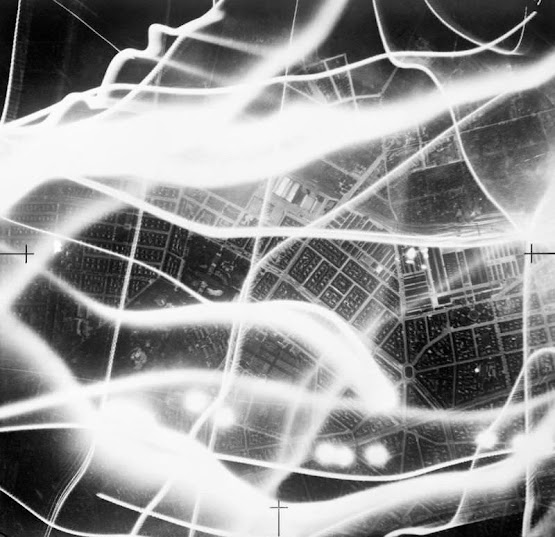Mansfield (pronounced manz-feeld)
The slang term for the
protective metal structures attached to the underside of trucks and trailers,
designed to protect occupants of vehicles in “under-run” crashes (the victim’s
vehicle impacting, often at mid-windscreen height with the solid frame of the
truck’s tray). A Mansfield bar, technically
is called the RUPS (Rear Underrun Protection System).
1967: The devices are known as “Mansfield” bars because interest in the system was heightened after the death of the actress Jayne Mansfield (1933-1967), killed in an under-run accident on 28 June 1967. The origin of the surname Mansfield is habitational with origins in Mansfield, Nottinghamshire. The early formations, recorded in the thirteenth century Domesday Book, show the first element uniformly as the Celtic Mam- (mother or breast (Manchester had a similar linkage)) with the later addition of the Old English feld (pasture, open country, field) as the second element. The locational sense is thus suggestive of an association of the field by a hill called “Man”. The etymology, one suspects, would have pleased Jayne Mansfield.
The "Mansfield crash" aftermath, 1966 Buick Electra 225, 28 June, 1967 (left) and the much re-printed photograph (right) of Sofia Loren (b 1934, left) and Jayne Mansfield (right), Romanoff's restaurant, Beverly Hills, Los Angeles, April 1957. Ms Loren's sideways glance, one of the most famous in Hollywood's long history of such looks has been variously interpreted as "sceptical", "disapproving" and "envious", the latter a view probably restricted to men. Ms Loren herself explained her look as one of genuine concern the pink satin gown might not prove equal to the occasion. On the night, there were several photographers covering the event and images taken from other angles illustrate why that concern was reasonable. There has never been any doubt Ms Mansfield's "wardrobe malfunction" was "engineered and rehearsed".
On 28 June 1967, Jayne Mansfield was a front-seat passenger in a 1966 Buick Electra 225 four-door hardtop, en route to New Orleans where she was next day to be the subject of an interview. While cruising along the highway at around two in the morning, the driver failed to perceive the semi-truck in front had slowed to a crawl because an anti-mosquito truck ahead was conducting fogging and blocking the lane. The mist from the spray masked the truck's trailer and, the driver unable to react in time, the car hit at high speed, sliding under the semi-trailer, killing instantly the three front-seat occupants. Although the myth has long circulated she was decapitated, an idea lent some credence by the visual ambiguity of photographs published at the time, while it was a severe head trauma, an autopsy determined the immediate cause of death was a "crushed skull with avulsion of cranium and brain". The phenomenon of the “under-run” accident happens with some frequency because of a co-incidence of dimensions in the machines using the roads. Pre-dating motorised transport, loading docks were built at a height of around four feet (48 inches; 1.2 m) because that was the most convenient height for men of average height engaged in loading and unloading goods. Horse-drawn carts and later trucks were built to conform to this standard so trays would always closely align with dock. Probably very shortly after cars and trucks began sharing roads, they started crashing into each other and, despite impact speeds and traffic volumes being relatively low, the under-run accident was noted in statistics as a particular type as early as 1927.
In the post-war years, speeds and traffic volumes rose and, coincidentally, the hood-lines (bonnet) on cars became lower, the windscreen now often somewhere around four feet high so the under-run vulnerability was exacerbated, cars now almost designed to slide under a truck to the point of the windscreen, thus turning the tray into a kind of horizontal guillotine, slicing into the passenger compartment at head-height. That’s exactly how Jayne Mansfield died and while the Buick was an imposing 223.4 inches (5,674 mm) in length, it was much lower than the sedans of earlier generations. As a footnote, when introduced in 1959, the Electra 225 (1959-1980) gained its name from being 225.4 inches (5,725 mm) long and while during the 1960s it would be just a little shorter, by 1970 it did again deserve the designation even by 1975 growing to 233.4 inches (5,928 mm), making it the longest four-door hardtop ever built by GM (General Motors), a record unlikely to be broken. The use of length as a model name was unusual but others have done it, most recently the Maybach (2002-2013), a revived marquee intended by Mercedes-Benz as a competitor for Rolls-Royce & Bentley. The Maybach was an impressive piece of engineering but its very existence only devalued the Mercedes-Benz brand and was an indication the MBAs who has supplanted the engineers as the company’s dynamic really didn’t have a clue, even about marketing which was supposed to be their forte. The Maybachs were designated “57” & “62”, the allusion to their length (5.7 & 6.2 metres respectively). Between 1948-2016, many Land Rovers were given model designation according to their wheelbase (with a bit or rounding up or down for convenience) in inches, thus "80", "88", "110" etc.
The US authorities did react, federal regulations requiring trucks and trailers be built with under-ride guards (reflectorized metal bars hanging beneath the back-end of trailers) passed in 1953, but the standards were rudimentary and until the incident in 1967, little attention was paid despite similar accidents killing hundreds each year. The statistics probably tended to get lost among the ever-increasing road-toll, cars of the era being death traps, seat belts and engineering to improve crashworthiness almost unknown. Predictably, the industry did its math (which took longer in the pre-spreadsheet era) and argued, given that above a certain speed impacts would still cause fatalities, the costs of retro-fitting heavy vehicles would be disproportionate to the number of lives saved or injuries avoided or made less severe. It's macabre math but it part of business and the most infamous example was Ford's numbers people working out it was projected to be cheaper to pay the costs associated with people being incinerated in rear-ended Pintos than it would be to re-engineer the fuel tank.
After 1967, although regulations were tightened and enforcement, though patchy, became more rigorous, deaths continued and in the US there are still an average of two-hundred fatalities annually in crashes involving Mansfield Bars. There are proposals by the Federal Motor Carrier Safety Administration (FMCSA) to include Mansfield Bars on any truck inspection and suggesting to improve the design to something more effective, the devices since 1963 little more than brute force impact barriers and there’s interest in spring-loaded devices which would absorb more of the energy generated in a crash. Coincidentally, the increasing preference by consumers for higher, bluff-fronted SUVs and light (a relative term, the "light" pick-up trucks popular in the US market regarded as "big" just about everywhere else, even in the Middle East, Australia and New Zealand where they're also sold) trucks has helped improve this aspect or road safety.
There’s concern too about side impacts. Only a very small numbers of trucks have ever been fitted with any side impact protection and this omission also make corner impacts especially dangerous. The cost of retro-fitting side (and therefore corner) Mansfield bars to a country’s entire heavy transport fleet would be onerous and it may be practical to phase in any mandatory requirements only over decades.
A photograph of a parked car & truck, the juxtaposition illustrating the limits of the protection afforded, especially in cases when the truck's tray extends well beyond the rear axle-line. The moving truck was one of two hired by Lindsay Lohan (b 1986) when in early 2012 she moved out of 419 Venice Way, Venice Beach, Los Angeles where during 2011 she lived (in the house to the right; the semi-mirrored construction sometimes called a “pigeon pair”) next door to former special friend DJ Samantha Ronson (b 1977) who inhabited the one to the left (417). She was compelled to move after a “freemason stalker threatened to kill her”, proving the Freemasons will stop at nothing.
Truganina, Melbourne, Australia, 4 June, 2025.
Mansfield bars can reduce injuries & fatalities but if the energy in a crash is sufficient (a product of mass, speed and the angle of contact at the point of impact), the consequences will still be catastrophic. In the early morning of 4 June 2025 in Melbourne, Australia, a Mustang coupé crashed into the right-rear corner of a parked truck, the passenger (sitting in the left front seat of the RHD (right-hand drive) car) killed instantly while the driver was taken to hospital with non-life-threatening injuries.
Truganina, Melbourne, Australia, 4 June, 2025.
The damage sustained by the vehicles was what would be expected in the circumstances, the truck (build on a rigid steel ladder-chassis with a steel-framed freight compartment atop) suffering relatively minor damage while the Mustang’s (built to modern safety standards with the structure outside the passenger compartment designed as a “crumple zone” intended to absorb an impact’s energy before it reaches the occupants) left-front corner substantially was destroyed. The right-side portion of the Mansfield bar which was hit was torn off in the impact, illustrating the limitations of the technology when speeds are very high, the same reason the car’s “safety cell” was unable to prevent a fatality.
The Seven Ups (1973).
Footage of crashes conducted during testing is illustrative but Hollywood does it better. In the movie The Seven Ups (1973, produced & directed by Philip D'Antoni (1929-2018), a 1973 Pontiac Ventura Custom, while pursuing a 1973 Pontiac Grand Ville, crashes into a truck with an impact similar to the one in which Jayne Mansfield died; this being Hollywood, the driver emerges bruised & bloodied but intact. In the movie, the truck is not fitted with a Mansfield bar but if the speed at the point of impact is sufficient, the physics are such that even such a device is unlikely to prevent fatalities. A re-allocation of a name used on Pontiac’s full-sized (B-Body) line between 1960-1970, the Ventura (1971-1977) was built on the GM (General Motors) compact platform (X-Body), until then exclusive to the Chevrolet Nova (1968-1979 and badged between 1962-1968 as the Chevy II).


























